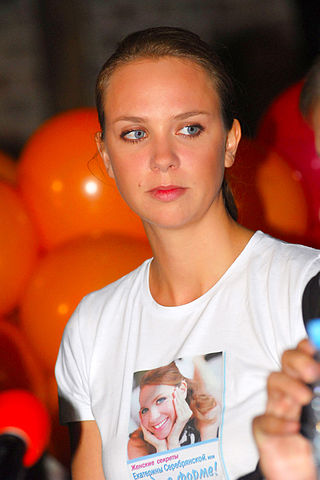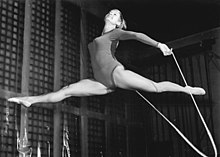
Gymnastics is a type of sport that includes physical exercises requiring balance, strength, flexibility, agility, coordination, artistry and endurance. The movements involved in gymnastics contribute to the development of the arms, legs, shoulders, back, chest, and abdominal muscle groups. Gymnastics evolved from exercises used by the ancient Greeks that included skills for mounting and dismounting a horse, and from circus performance skills.

In gymnastics, the floor is a specially prepared exercise surface, considered an apparatus. The floor exercise is the event performed on the floor, in both women's and men's artistic gymnastics. The same floor is used for WAG FX and MAG FX, but rules and scoring differ; most obviously, a WAG FX routine is synchronised to a piece of recorded dance music, whereas MAG FX has no musical accompaniment.

Rhythmic gymnastics is a sport in which gymnasts perform individually or in groups on a floor with an apparatus: hoop, ball, clubs, ribbon and rope. The sport combines elements of gymnastics, dance and calisthenics; gymnasts must be strong, flexible, agile, dexterous and coordinated. Rhythmic gymnastics is governed by the International Gymnastics Federation (FIG), which first recognized it as a sport in 1963. At the international level, rhythmic gymnastics is a women-only sport.

A trapeze is a short horizontal bar hung by ropes, metal straps, or chains, from a ceiling support. It is an aerial apparatus commonly found in circus performances. Trapeze acts may be static, spinning, swinging or flying, and may be performed solo, double, triple or as a group act.

A skipping rope or jump rope is a tool used in the sport of skipping/jump rope where one or more participants jump over a rope swung so that it passes under their feet and over their heads. There are multiple subsets of skipping/jump rope, including single freestyle, single speed, pairs, three-person speed, and three-person freestyle.

Kateryna Serebrianska[a] is a Ukrainian former individual rhythmic gymnast. She is the 1996 Olympics gold medalist, the 1995 World All-around champion, the 1996 European All-around champion, and three time Grand Prix Final All-around champion.

The ball is an apparatus used in the sport of rhythmic gymnastics. It is one of the five apparatuses utilized in this discipline, alongside the clubs, hoop, ribbon, and rope.

The clubs are an apparatus used in the sport of rhythmic gymnastics. They are one of the five apparatuses utilized in this discipline, alongside the ball, hoop, ribbon, and rope.

The hoop is an apparatus used in the sport of rhythmic gymnastics. It is one of the five apparatuses utilized in this discipline, alongside the ball, clubs, ribbon, and rope.

The ribbon is an apparatus used in the sport of rhythmic gymnastics. It is one of the five apparatuses utilized in this discipline, alongside the ball, clubs, hoop, and rope.

Twirling is a form of object manipulation where an object is twirled by one or two hands, the fingers or by other parts of the body. Twirling practice manipulates the object in circular or near circular patterns. It can also be done indirectly by the use of another object or objects as in the case of devil stick manipulation where handsticks are used. Twirling is performed as a hobby, sport, exercise or performance.

Iliana Raycheva Raeva-Sirakova is a Bulgarian gymnast who competed in modern rhythmic gymnastics for her country from 1978 to 1983 . She was one of the Golden Girls of Bulgaria that dominated Rhythmic Gymnastics in 1980s.
This is a general glossary of the terms used in the sport of gymnastics.

Evgeniya Olegovna Kanaeva OMF is a retired Russian individual rhythmic gymnast. She is the only individual rhythmic gymnast in history to win two Olympic all-around gold medals, winning at the 2008 Summer Olympics, where she finished with 3.75 points ahead of silver medalist Inna Zhukova, and at the 2012 Summer Olympics, where she also became the oldest gymnast to win the Olympic gold. On 4 July 2013, Kanaeva received the International Fair Play Award for "Sport and Life".

Yana Alexeyevna Kudryavtseva is a retired Russian individual rhythmic gymnast. She is the 2016 Olympic All-around silver medalist, three-time World Champion in the All-around (2013–2015), the 2015 European Games All-around champion, two-time European Championships All-around champion, the 2012 European Junior ball champion. In national level, she is a two-time Russian National All-around champion and three time Russian Junior National all-around champion.
Alexandra Ana Maria Agiurgiuculese is a Romanian-Italian individual rhythmic gymnast who represents Italy. She is a World Championships silver and bronze medalist, and she competed at the 2020 Summer Olympics. Agiurgiuculese was the first Italian gymnast to win the Longines Prize for Elegance. At the national level, she is the 2019 Italian National all-around champion and three-time Italian National all-around silver medalist.

The 2018 Rhythmic Gymnastics World Championships were held in Sofia, Bulgaria, from 10 to 16 September 2018 at Arena Armeec. The top three countries in the group all-around, Russia, Italy, and Bulgaria won the first three spots for the 2020 Olympic Games. Russia was the most successful nation of the competition with seven of the nine gold medals, and Bulgaria and Italy each won a title.

Physical training has been present in human societies throughout history. Usually, it was performed for the purposes of preparing for physical competition or display, improving physical, emotional and mental health, and looking attractive. It took a variety of different forms but quick dynamic exercises were favoured over slow or more static ones. For example, running, jumping, wrestling, gymnastics and throwing heavy stones are mentioned frequently in historical sources and emphasised as being highly effective training methods. Notably, they are also forms of exercise which are readily achievable for most people to some extent or another.

Stiliana Nikolova is a Bulgarian individual rhythmic gymnast. She is the 2024 European all-around champion, the 2022 World all-around bronze medalist and hoop, clubs, and ribbon silver medalist, the 2023 World ball bronze medalist and team competition champion, and a two-time European all-around bronze medalist and champion in the team competition. At the national level, she is a two-time national champion and the 2022 national all-around silver medalist. She competed at the 2024 Summer Olympics, where she came in 11th place.





















